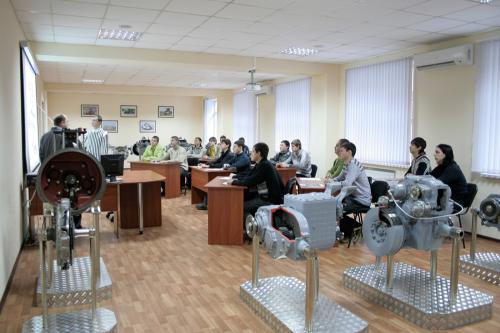
kscarbel2
Moderator-
Posts
18,550 -
Joined
-
Days Won
112
Content Type
Profiles
Forums
Gallery
Events
Blogs
BMT Wiki
Collections
Store
Everything posted by kscarbel2
-
Scania Group Press Release / January 13, 2016 In 1936, a 1928 Scania-Vabis type 3256 truck plowing snow on Lake Fryken for a winter horse-racing track sank through the ice to a depth of 67 meters. After being on the bottom of the lake for almost 49 years, the truck was located in 1984 and brought back to the surface in 1985 by members of the North Varmland Veteran Technicians Club in Torsby. Restored to like-new condition, the truck today consists of 80 percent original parts.
-
- 3
-

-
Dakar 2016: Team Petronas De Rooy Iveco aims for victory
kscarbel2 replied to kscarbel2's topic in Trucking News
1/14/2016 Iveco and De Rooy are consolidating their lead in the Dakar Rally Gerard de Rooy and his Iveco Powerstar had another great day in the one of the most difficult stage with sand and dunes of the 2016 Dakar and took advantage of a very tough navigational stage to gain an even stronger lead in the general. The tenth special of the competition connected the cities of Belén and La Rioja, and included a must-have feature of every Dakar: dunes. In fact, the huge mountains of sand in Fiambalá crushed the hopes of many participants, but that wasn't the case with Iveco. The stage got off to an interesting start, with the top 10 Cars, 5 Trucks and 5 Bikes from nine's race all together. This meant that De Rooy, Villagra and Van Genugten of Iveco, and Karginov and Nikolaev of Kamaz, began the race one hour before the rest. De Rooy coped with this the best. Van Genugten and Villagra, who was winning the stage until the last waypoint, got lost in the last section and crossed the finish line 1 hour and 38 minutes and 52 minutes, respectively, behind their Dutch team leader. The Kamazes had even more trouble and that is why De Rooy had such a good day, gaining an even bigger lead in the general classification, in spite of having come in 2nd position, only 2 minutes and 36 seconds behind the surprising leader, Pascal De Baar, who won today's stage with Renault Trucks. The experienced Spanish pilot Pep Vila, aboard an Iveco Trakker, finished the day in 11th place and didn't lose as much time as other pilots did, but came in 1 hour 11 minutes and 4 seconds behind the leader. In the general, he was able to climb up a couple positions and is getting closer and closer to the Top 10 in the general. After the tenth stage, Vila is currently in 11th place, 15 minutes behind the competitor that is just ahead of him. Finally, the Kamazes piloted by Nikolaev and Karginov, which took off together with the first three Iveco trucks, finished the Belén-La Rioja stretch more than 3 hours and 30 minutes behind Gerard de Rooy and lost all chances of victory. Gerard de Rooy is now way ahead in the general, with a 1 hour 15 minute and 19 second lead over his closest rival, the Russian pilot Airat Mardeev, who is driving a Kamaz. Villagra is now the second Iveco pilot on the podium, and Ton van Genugten, currently in 5th place, brought another Iveco truck into the Top 5, just behind Hans Stacey and his MAN. Stage 10 Trucks 1. De Baar (NLD), Renault Trucks – 4:51:41 plus 2 minutes 36 seconds-2. GERARD DE ROOY (NLD), IVECO 3. Mardeev (RUS), Kamaz – plus 26 minutes 6 seconds 4. Kolomy (CZE), Tatra - plus 26 minutes 25 seconds 5. Stacey (NLD), MAN – plus 27 minutes 25 seconds 9. FEDERICO VILLAGRA (ARG), IVECO – plus 53 minutes 59 seconds 11. PEP VILA (SPA), IVECO – plus 1 hour 11 minutes 4 seconds 15. TON VAN GENUGTEN (NLD), IVECO – plus 1 hour 34 minutes 29 seconds General Classification − Trucks 1. GERARD DE ROOY (NLD), IVECO − 33:25:03 2. Mardeev (RUS), Kamaz – plus 1 hour 15 minutes 19 seconds 3. FEDERICO VILLAGRA (ARG), IVECO – plus 1 hour 32 minutes 47 seconds 4. Stacey (NLD), MAN – plus 1 hour 48 minutes 57 seconds 5. TON VAN GENUGTEN (NLD), IVECO – plus 2 hours 16 minutes 55 seconds 11. PEP VILA (SPA), IVECO – plus 4 hours 11 minutes 54 seconds - ALEŠ LOPRAIS (CZE), IVECO – dropped out To learn more about Iveco's teams and vehicles and to follow Iveco day-by-day throughout the race, visit www.iveco.com/dakar. -
http://kfor.com/2016/01/13/all-lanes-of-traffic-shut-down-due-to-large-oil-rig-fire/
-
FYI: Some Mack trivia As you know, Ford introduced its cutting edge new model year 1996 HN80 Ford Aeromax and Louisville at the 1995 Detroit auto show. (http://www.bigmacktrucks.com/index.php?/topic/41662-a-look-back-at-american-innovation-the-ford-hn80-new-aeromax-and-louisville/?hl=hn80) (Ford filed for the Aeromax name in August 1987, abandoned it in September 1989, and filed again for the name in March 1995.) But for the record, Mack Trucks applied for a trademark on the term Aero-Max in August 1987, and it was registered in February 1990. (Volvo Group cancelled the registration of the Aero-Max term in March 2001). When the CH was being developed in the 1980s, it wasn't alone. The Mack CH was the modern and versatile replacement of the R-model. Like the R-model, the CH had no special aerodynamic features. Noting Kenworth’s success with the aerodynamic new-for-1985 Kenworth T600, Mack created a highly aerodynamic prototype variant of the CH called the CA, or Aero-Max. And it was breathtaking in appearance, a truly revolutionary and modern design. A DH was being developed and tested to replace the DM, utilizing a CH-style cab. Like the CH, the DH was a sharp looking truck, an impressive leap forward in vocational truck design. In summary, Mack R&D had three options on the table for the sales group to consider for production: CA - aerodynamic tractor for the 1990s CH - modern replacement for the industry-leading R-model DH - modern replacement for the industry-leading DM
-
If I remember correctly, Mack's Centri-Max centrifugal oil filter came out in 1986. We trademarked the name in December 1985.
-
Scania has used centrifugal oil filtration for decades. Recall that the Scania-sourced 7.9-liter mid-range engines featured this technology which Mack Trucks later adopted. Spinning at 5000 rpm, the centrifugal oil cleaner removes smaller particles than are trapped by spin-on filters. The ability to scrutinize residue makes the centrifugal cleaner a window to the inside of the engine -- an early warning to excessive engine wear. They can immensely extended engine life. Did you know that all Scania drive axle carriers (differentials) feature a spin-on oil filter?
-
Two teenage girls face trial in Colorado for planning mass school shooting The Guardian / January 14, 2016 Two 16-year-olds have been charged with plotting a mass shooting at their suburban Denver high school. Brooke Higgins, who was charged on Thursday, and Sienna Johnson, who was charged last week, will both be tried as adults on two counts of conspiracy to commit first-degree murder, in a district court in Castle Rock, Colorado. The girls took what the prosecution called “overt acts” towards purchasing firearms in order to carry out their plan, assistant district attorney Jason Siers told the court on Thursday. Prosecutors said the two girls worshipped the Columbine shooters, and the movie Natural Born Killers. They had specific targets, the prosecution said, but everyone at the school was a potential victim. Entries on social networking sites show moody pictures of blood-spattered walls, and hand-scrawled journal entries filled with anguished prose. On Thursday, district court judge Paul King set her bond at $1m, as he had for Johnson. The cases are currently under seal, and a motion filed by a consortium of media to remove that seal from the case file was denied by King, though he did allow the trials to take place in open court. Highlands Ranch, Colorado, is a satellite suburban town about 25 miles south of Denver. Nestled among snowy brush-covered hillocks, its skyline is dominated by the distant Rockies and little else. It is a town of cookie-cutter houses in uniform blue-grey and beige. Columbine, probably America’s most infamous school shooting, is a quarter-hour drive north-west. Aurora, where 12 people were murdered at a midnight screening of The Dark Knight Rises three years ago, is about a half-hour north-east. Colorado Springs, site of two shootings in as many months in October and November 2015, is an hour south. It was through an anonymous text hotline begun after the 1999 Columbine shooting that the Mountain Vista high school plot was supposedly uncovered. In fact, Columbine looms large over the whole alleged plot. On 10 December, Higgins took a picture of the road outside Columbine high school, and Googled the names of the shooters. She also wrote about how she wished she had done Columbine with them. In setting the strict bond conditions for Higgins on Thursday, Judge King addressed the issue of the cult of Columbine directly. “The idea that the incident at Columbine is to be admired, that the people who did that are gods or heroes …” he paused. “There are parents in this city that want to make sure their kids are protected.” The sheriff’s office and the district attorney say the girls had planned their attack in the days running up to Christmas, and that Johnson had practised shooting with BB guns. When she was arrested that, Johnson said were she released, she would go back to plotting a shooting. Referring to Higgins, Johnson had written in her diary in 2015 about meeting someone “who’s got what it takes to … make this school a living [expletive] nightmare”. “God, Brooke and me will be unstoppable,” Johnson wrote. .
-
KrAZ Trucks - A Socially Responsible Company
kscarbel2 replied to kscarbel2's topic in Trucking News
You so so right Tim. -
The Wall Street Journal / January 13, 2016 FBI Director James Comey says his department is investigating the shooting of a Philadelphia police officer last week as a suspected act of terrorism. Philadelphia police arrested 30-year-old Edward Archer for shooting police officer Jesse Hartnett three times in a late-night ambush as the officer was in his patrol car. Mr. Hartnett, who was shot in the arm, is being treated at a hospital. 'This is absolutely one of the scariest things I've ever seen,' said Police Commissioner Richard Ross. 'This guy tried to execute the police officer. The police officer had no idea he was coming.' Ross said Hartnett was in his patrol car in West Philadelphia when the shooter approached from the sidewalk. He then began firing, eventually shooting through the driver's-side window as he got closer. Archer told detectives he was inspired by ISIS. Investigators are closely scrutinizing Mr. Archer’s background, including his trip to Saudi Arabia in late 2011 and another to Egypt in 2012. Police arrested Archer shortly after the shooting and recovered a 9mm pistol they believe was used in the incident. The gun was reported stolen in 2013 from the home of a police officer, but it is unclear how Archer obtained the weapon. Archer has been charged with attempted murder, aggravated assault and gun crimes. Archer has a criminal history. In November, he was convicted of forgery, driving without a valid license and four other charges in Delaware County outside Philadelphia. .
-
KrAZ Trucks Press Release / January 12, 2016 Kraz Trucks (aka AutoKrAZ), the only manufacturer of heavy trucks in Ukraine, is the largest employer in the City of Kremenchug, with tax payments amounting to over UAH 74m (US$3.2 million) in 2015. Income tax paid was UAH 18m (US$772,200), military levy was UAH 2m (US$85,800), and unified social tax was UAH 54m (US$2.3 million). KrAZ Trucks is known as one of the most socially responsible companies in Kremenchug and the Poltava region. Despite political and economic crisis in the country, the truckmaker maintained the stable performance and raised the wages of its employees. Since the beginning of 2015, KrAZ was able to raise wages 15 percent over the previous year. KrAZ’s Kremenchug truck plant currently employs over 3,500 full-time workers, with production staff accounting for 97 percent of that total. Throughout 2015, the company hired 277 new workers, 87 of them graduated from vocational schools. The average employee age is 45 years. There were no personnel cuts in 2015. Rather, the company continued to hire in support of growth. The company’s focus was on developing its social sphere in 2015. KrAZ Trucks contributed UAH 5,5m (US$235,950) to fund the construction of new facilities including a cafeteria, social hall and employee homes. We also renovated our KrAZ truck museum. In addition, we spend UAH 1m (US$42,900) over year 2015 on employee training. In 2016, KrAZ Trucks plans to continue reinvesting a sizable portion of our rising profitability in employee-related areas, in support of optimized working conditions and quality of life. .
-
Owner/Driver / January 14, 2016 A convoy of more than 100 trucks hauled bales of hay to drought-affected farmers in Queensland. Burrumbuttock Hay Runners founder Brendan Farrell has dismissed the praise heaped on him after the 125-truck convoy he organised delivered more than 5,000 bales of hay to drought-stricken farmers in Queensland. Requiring trucks, drivers, catering, donations, hay, and months of planning, the Burrumbuttock Hay Runners convoy travelled 1860km from New South Wales to provide about 270 cattle farmers with the much-needed feed. Speaking in a video posted to the Burrumbuttock Hay Runners Facebook page, Farrell says it was a "fantastic, successful hay run" taking "a couple of big days", but downplayed any personal credit. "Social media is putting a lot of pressure on me, saying I’m famous and all this other type of thing – but people need to realise I’m just a bloke with a truck," he says. "You don’t have to be famous to help people. "You don’t need to have a million dollars to help people. "You put your hand up and you just get on and do it." Some calls have come for the Riverina local to be crowned Australian of the Year, an honour Farrell has also dismissed. "All the stuff about Australian of the Year…nah, I don’t have time for that," he says. A number of thankful farmers took to the Facebook page to show their gratitude for all the drivers, contributors and Farrell. "My family were one of the grateful recipients of the hay and it was not just the hay, it was the fact that that amazing group cared enough to make the long trek up here," Jo Thomas says. "Everyone had a smile, there were tears and cheers and everyone went home feeling a whole lot lighter and more positive." Truck drivers also took to the page, including Trevor Vale who left a heartfelt video message. "I want to congratulate those truckies out there that took part in the Burrumbuttock hay run…you’ve done everything you could to help those farmers," Vale says. "A lot of people in the city sit back and don’t take much notice of what’s going on out there, but those truck drivers know exactly what’s going on out there." Pitching in to help with the run was Freightliner Racing transporter driver Paul ‘Stax’ Eddy, who swapped his regular load of two V8 Supercars and race equipment for 32 bales of donated hay. "The farmers are really doing it tough up there," Eddy says. "They have had no rain for so long that they could really do with a little help." The run was the biggest in the convoy’s two-year history and marks the 10th Farrell has organised since February 2014, when 20 trucks travelled from Burrumbuttock to Bourke. Farrell originally planned to cart the hay to Aramac but changed the destination to Ilfracombe due to concerns the roads would not handle the large number of trucks, especially if it rained. Aramac is about 100km north-east of Ilfracombe. More than 20,500 bales of hay have been donated in the last two years by the Burrumbuttock Hay Runners. While he was unwilling to accept any praise in the wake of the latest convoy, the thankfulness of the farmers has not gone unacknowledged. "You go to a small country town and you’ve got 100 and 200 people on the side of the road waving, saying thank you," Farrell explained last year. "I get very satisfied when I know that I’ve helped the community, just to let them know that someone gives a damn. "Australia has lost its way on how to give. "I’m just trying to put the message out there that there are still people that want to help." Details on future runs and how to donate are available on the Burrumbuttock Hay Runners Facebook page. https://www.youtube.com/watch?v=JzZ5_iRF8Xo
-
(HIno) Dakar Rally 2016 Kicks Off in Buenos Aires
kscarbel2 replied to kscarbel2's topic in Trucking News
Trucks Show Their Mettle Off-Piste and on Dunes in Looped Course Hino Trucks Press Release / January 13, 2016 Car 2 finishes at 9th overall, marking its spot in the top 10. January 12: Teams raced on a looped course this day that started and finished at Belén, Argentina with a special coursing through the southeastern part of Belén on the opposite side of Fiambala desert. Most of the course was off-piste (off-road wastelands), and was reminiscent of northern Africa with its fluffy grass-covered dunes and dried riverbeds. With the temperature soaring above 40ºC and road surface resistance keeping the vehicles from picking up speed, this was a stage where overheating became a major risk. The SS for the day was scheduled to be 285km long, but was cut short at CP (checkpoint) 2 due to the extreme heat. The cars and trucks headed for the bivouac in Belén on a 5km liaison, and motorbikes set out for their special marathon bivouac on another route. Teruhito Sugawara and Hiroyuki Sugiura on Car 2 took full advantage of the mobility of their HINO500 Series truck to deliver outstanding performance. The crew finished at 9th in the overall Trucks category and top in the Under 10-litre Class, making their first foray into the top 10 this year. Meanwhile, the Yoshimasa Sugawara and Mitsugu Takahashi crew on Car 1 maintained a brisk pace―all the while paying close attention to their coolant temperature―finishing the special at 30th overall and 2nd in the class. Based on these results, Car 2 now climbs to 15th place, and Car 1 to 35th place in the overall Trucks category. The two trucks continue to maintain their one-two lead in the Under 10-litre Class. The SS for tomorrow, January 13, is set to make one round through the notoriously challenging Fiambala Desert on its way from Belén to La Rioja. Yoshimasa Sugawara: The coolant temperature got quite high so we turned on the heater to let the engine release as much of its heat as possible. As you can imagine, it got very hot in the cabin. We kept pouring drinking water over our bodies so our racing suits are drenched. Mitsugu Takahashi: This was a brutal stage, so you can’t blame the organizers for cutting it short at CP2. The majority of the course was off-piste and it was another day of mostly CAP (compass bearing) navigation. I was a bit anxious of the rather big intervals between the block drawings in the road book, but that didn’t end up being a problem. Teruhito Sugawara: The fact that many vehicles had to stop on the side of the course is surely one of the reasons for our good finish position, but we also did make good time. This was another confirmation that the directions we set for the trucks’ construction were spot on. I can’t blame the organizers for canceling the race at CP2. Hiroyuki Sugiura: The sand was soft in today’s stage, so I think it must have been tough for cars running behind trucks. On these types of terrain, road surface conditions can vary dramatically depending on how soon or late you cross any given point. Photo gallery - http://www.hino-global.com/dakar/latest_news/PD16-21.html -
Indiana To Use Cameras To Crack Down On Overweight Trucks
kscarbel2 replied to kscarbel2's topic in Trucking News
Truckers may pay more to haul in Indiana CNHI / January 12, 2016 In a state known as the “Crossroads of America,” the number of overweight trucks has tripled in less than a decade, accelerating damage to aging roads and bridges. More than 380,000 trucks that exceed federal weight and size standards were permitted to travel in Indiana last year, up from about 135,000 in 2007. Those numbers are part of the reason why some lawmakers want the trucking industry to pay more for infrastructure. Under a plan proposed Monday by House Republican leaders, private carriers would pay about 7 percent more for diesel fuel - in taxes and a surcharge - than what they pay now. The measure is getting surprising support from the Indiana Motor Truck Association, which represents truckers who carry goods from about 80 percent of Indiana manufacturers. “We’ve been saying at the federal and state level that we need to raise taxes on fuel and fix the roads,” said Gary Langston, association president. “We’ve been saying that for a long time. “Bad roads and congested highways cost us money,” he said. The House Republican plan would automatically adjust the state’s fuel tax for inflation, resulting this year in a 4-cent hike on a gallon of gasoline for all motorists, including truckers who use diesel fuel. It also raises the motor-carrier surcharge, paid quarterly by trucking companies, by another 3 cents per gallon. Those increases combined are expected to raise $60 million a year for road and bridge repair. It’s just a fraction of the $1 billion needed in for infrastructure, but supporters say it will make a dent. In addition, the measure allows local governments to charge a higher “wheel tax” on buses, trailers and trucks that are licensed in their counties. Under current law, truck-owners pay the same as car-owners. House Ways and Means Chairman Tim Brown, R-Crawfordsville, said the plan acknowledges that trucks create more wear on roads than cars. A Purdue University study found a single, 40-ton truck can do as much damage to roadway pavement as 9,600 cars. Last week, an overweight truck broke a one-lane, 133-year-old bridge in small town Paoli. Police said the driver, carrying 43,000 pounds of bottled water, tried to cross a bridge with a weight limit of 6,000 pounds. The broken bridge, costing about $1 million to repair, is an extreme example of truck damage, said Rep. Steve Davisson, R-Salem, whose district includes Paoli. “But, every day, heavy trucks are beating the dickens out of highways and bridges,” he said. “So the question is, ‘Are they paying enough for maintenance of our roads?’ “ Under current law, Indiana requires any vehicle over 40 tons to acquire a special permit that certifies the load is properly configured to minimize roadway damage. The state charges $55 for an overweight permit, plus up to $1 per mile for loads that exceed the 40-ton weight. Those fees won’t change under the proposed plan. What may lie ahead, though, is a crackdown on trucks that fail to pay. Since January 2013, State Police have issued 13,000 tickets to drivers of illegally overweight trucks and another 11,000 warnings. Police worry they may only be catching a fraction of offenders. In response, transportation officials are launching a pilot project this spring to determine how many illegally overweight trucks are passing through the state. The project will use cameras, and a weight-and-motion sensor embedded in a section of busy Interstate 94 in northern Indiana, to track heavy trucks and capture their license plate numbers. If successful, the technology could be used throughout the state to issue fines for violators, transportation officials say. -
NY-NJ Port Authority Revises Older-Trucks Plan
kscarbel2 replied to kscarbel2's topic in Trucking News
Port Authority drops plan for banning older trucks at ports The Washington Times / January 12, 2016 The Port Authority of New York and New Jersey has reversed plans to ban older trucks that fail to meet emission standards from hauling cargo at the Newark and Elizabeth seaports. The agency and the U.S. Environmental Protection Agency announced five years ago they would deny entry to all trucks that didn’t meet 2007 federal emission standards beginning next year to help improve air quality, but officials said they underestimated the cost. Port Authority spokesman Steve Coleman told The Record (bit.ly/1ULH56u) newspaper it would have cost more than $150 million in grants to drivers to help replace 6,300 trucks built before 2007. “Nobody realized the scope of the issue then compared to today,” Coleman said. The agency is instead committing $1.2 million to help drivers who own their own vehicles to replace about 400 trucks, along with $9 million from federal agencies. Trucks that are older than 2007 and already registered at the ports will still be able to pick up and drop off cargo. Older trucks that aren’t registered will be banned. Clean-air advocates, upset by the move, said the Port Authority had detailed numbers in 2010 on how many trucks they would have to deal with by 2017. “For them to say they didn’t know the scope of the problem is absurd,” said Amy Goldsmith, chairwoman of the Coalition for Healthy Ports. Coleman said that of the 9,000 trucks that regularly serve the ports, about 2,700 have newer, cleaner engines. “We’re stopping the bleeding,” Coleman said. “Older trucks won’t be added to the registry.” -
Scania Group Press Release / January 13, 2016 From horses to the modular system. Join us on a historic journey through decades of fire fighting from all around the world.
-
- 1
-

-
Tatra Trucks Press Release / January 13, 2016 The long-distance Rally Africa Eco Race 2016, following in the footsteps of the original Dakar Rally through Morocco, Mauritania and Senegal, is now history. Tomas Tomeček took the silver in the truck category with the TATRA 815! The three-time winner of the rally, in 2011, 2012 and 2014, joined his navigator Ladislav Lala and a team of two other accompanying Tatra trucks, to give their fans a wonderful gift on the occasion of the 30th anniversary of the first start of TATRA vehicles in the Dakar Rally. Thirty years ago, two company teams led by Karel Loprais and Zdenek Kahanek competed there. Neither of them finished the race at that time, but one year later Karel Loprais won the silver for the Paris – Dakar Rally. In a race that symbolically started on December 27 in Monaco, with the real start taking place on December 29 in Morocco, Tomas Tomeček suffered a lot of bad luck at the very beginning when his Promet/Excalibur Team had three punctures in the 4th stage and thus were way back of the pack. But Tomeček's TATRA 815 was able to catch up in the Sahara dunes, where they won 2 stage victories and one stage silver. Thank to this "surge", Tomas Tomeček managed to reach 2nd place, which he held until the 11th stage, which ended on September 1, 2016. The only Czech representative at the Africa Eco Race was thirteenth overall in the car classification, while in the truck category he lost out only to Russian Anton Shibalov and his Kamaz, who defended his last year's victory. For more about Tomas Tomeček at Africa Eco Race 2016, please visit the website www.tomastomecek.cz. Our congratulations to Tomas Tomeček and thanks for representing us! Photo gallery - http://www.tatratrucks.com/about-the-company/press-and-media/news/tomecek-celebrates-the-30th-anniversary-of-tatra-at-the-dakar-rally-with-a-second-place-finish/
-
Scania Group Press Release / January 13, 2016 In the late 60's and early 70's a few daring men drove what became a legendary truck route with The Bandar Abbas Express, from Norway to Iran.
-
Dakar 2016: Team Petronas De Rooy Iveco aims for victory
kscarbel2 replied to kscarbel2's topic in Trucking News
1/13/2016 Dakar 2016: new stage victory for Iveco and double podium in the General Gerard de Rooy solidified his first-place position in the 2016 Dakar after his second consecutive win in a shortened race, due to the high temperatures in the dunes of Catamarca. ASO had scheduled a special for all four categories that would begin and end in the city of Belén, located in northeastern Argentina, and that would cover 285 timed kilometers. However, temperatures exceeding 50°C (122°F) forced the ASO to cancel the stretch beyond CP2, so the course was shortened to 178 kilometers. In stage 9, Iveco was once again proclaimed the day's winner thanks to Gerard de Rooy, who –along with his teammates, Moi Tarrollardona and Darek Rodewald– is proving to be the best in the navigation stages. With yesterday's victory, the winner of the 2012 Dakar claimed his third triumph in this edition and put plenty of distance between himself and the current runner-up, the Russian pilot Eduard Nikolaev. The Kamaz pilot is now 27 minutes and 12 seconds behind De Rooy in the general after coming in 5th in Stage 9. "Brilliant victory, but it wasn't easy. It was really hot and the sand was very soft. Cutting the race short at CP2 was the right decision," said Gerard de Rooy, who added: "Everyone got stuck and got flat tires. The pressure in our tires was carefully managed by Darek and Moi didn't make any navigational mistakes". Iveco also took second place in the Belén-Belén loop, with the Trakker piloted by Ton van Genugten. The other Dutchman in the fleet crossed the finish line just 3 minutes and 59 seconds behind Gerard de Rooy and climbed to 5th place in the general after nine stages in this 2016 Dakar. Federico Villagra and his Iveco Powerstar finished the day in 4th place, 16 minutes and 45 seconds behind the winner, and thanks to the delays suffered by Hans Stacey, Pieter Versluis and Ariat Mardeev, he rose to 3rd place on the podium in overall time. The Argentine pilot had to stop a couple of times to help his co-pilot Jorge Pérez Companc deal with breakdowns caused by the conditions of this stage. After stage 9, Iveco now has two pilots in the Top 3 and three trucks in the Top 5 in the general. Pep Vila had a more complicated day and lost start-up time before the first WP. The Spaniard was 40 minutes behind the leader at the first checkpoint and ended the day in 23rd place, more than an hour behind the leaders. This also led him to fall in the general classification, where he is now in 13th place but still has a good chance of making it into the Top 10. Stage 9 Trucks 1. GERARD DE ROOY (NLD), IVECO − 2:41:20 2. TON VAN GENUGTEN (NLD), IVECO – plus 3 minutes 59 seconds 3. Karginov (RUS), Kamaz – plus 16 minutes 04 seconds 4. FEDERICO VILLAGRA (ARG), IVECO – plus 16 minutes 45 seconds 5. Nikolaev (RUS), Kamaz – plus 19 minutes 14 seconds 23. PEP VILA (SPA), IVECO – plus 1:13:35 General Classification − Trucks 28:30:46-1. GERARD DE ROOY (NLD), IVECO 2. Nikolaev (RUS), Kamaz – plus 27 minutes 12 seconds 3. FEDERICO VILLAGRA (ARG), IVECO – plus 41 minutes 24 seconds 4. Versluis (NLD), MAN – plus 44 minutes 0 seconds 5. TON VAN GENUGTEN (NLD), IVECO – plus 45 minutes 2 seconds 13. PEP VILA (SPA), IVECO – plus 3 hours 3 minutes 26 seconds To learn more about Iveco's teams and vehicles and to follow Iveco day-by-day throughout the race, visit www.iveco.com/dakar -
Nikkei Asian Review / January 14, 2016 While the lowest crude oil prices in more than a decade should be a good thing for the U.S. and other energy-hungry nations, fears are growing that the global economy will be left worse off. West Texas Intermediate was trading back above $30 a barrel Wednesday morning after slipping under that level for the first time in 12 years the day before. Even so, the U.S. benchmark remains well below the mid-$50 range that many companies and economists had been predicting. This bear market could hurt the global economy in three ways. First, the pain that oil-producing nations now feel could spread to advanced economies. Steelmakers are voicing anxiety over the prospect of oil field project delays or suspensions. Demand for the steel pipe used in well drilling is already down, and executives fear that it may worsen. We can't simply rejoice over lower energy costs. There will be a negative impact on business in resource-producing nations. The second way oil could slow global growth is through the financial markets. Falling share prices, rising developed-nation currencies and increased risk avoidance pose risks to real economic activity. So far, the disquiet in the markets has not spread. But it may yet depress consumer sentiment or make banks less eager to lend. The third vector runs through the Middle East, where plunging oil revenues threaten to deepen the region's turmoil. In oil-consuming nations, corporate earnings may get a boost, but amid slowing economic growth, the bulk of the savings will be banked rather than channeled into capital or consumer spending. A 10% fall in the price of crude translates to a 0.76% drop in global industrial output six months later. Cheap crude looks to be here to stay for a while. The U.S. Energy Information Administration on Tuesday lowered its forecast for the average WTI price this year to $38.54 from $50.89. It sees the average price rebounding to only $47 next year. Chinese demand for crude may have further to fall. American inventories of petroleum products are on the rise. On the supply side, some fiscally hard-pressed oil-producing nations have been forced to devalue their currencies as the dollar gains strength. This could end up discouraging production cutbacks by improving the profitability of their oil exports, analysts say. Companies involved in the oil business naturally have greater reason to worry than others. Japanese trading house Mitsui & Co.'s fiscal 2015 forecasts assume an oil price of $56 a barrel in the October-March half. Every $1 shortfall cuts $22.7 million a year off its profit.
-
Fleet Owner / January 13, 2016 Australia is in the process of eliminating pay by the mile for many of its truck drivers, and replacing it with guaranteed minimum hourly wages, a program the government is calling “safe rates.” The program was approved last month by that government’s Road Safety Remuneration Tribunal and will go into effect on April 4 for owner-operators who are in the long-haul and food services market sectors. Two speakers at a panel session at the Transportation Research Board’s 95th annual meeting here this week provided details of the program. Glenn Sterle, a member of the Australian senate and a supporter of the program, said the safe rates program is the culmination “of 20 years of hard work” by a bipartisan coalition of legislators who were looking to improve highway safety in the country. The first fruit of that effort, he said, was the national legislature’s 2012 creation of the RSRT as a tripartite panel comprised of government, fleet and labor representatives. The agency said it is also currently at work at extending the hourly-wage requirement to drivers who work in drayage, waste management and fuel sectors. Tony Sheldon, national secretary of Australia’s Transport Workers’ Union, said his country records an average of 330 heavy-truck-related fatalities a year and that trucking is by far the most dangerous occupation in the land, “11 times higher than any other industry.” He said a union survey found that 33% of drivers surveyed admitted that they had used stimulants in the past year in order to keep driving when fatigued. Sheldon said the survey might well have understated the actual percentage of drivers who take the drugs. Sheldon said Australian law now permits owner-operators to bargain collectively with fleets, and that as a result about 23% of all drivers are union members. Union membership at American fleets is about 8% by comparison, according to Michael H. Belzer, a professor at Wayne State University who has written extensively about trucking and chaired the TRB panel where the Australians spoke. The annual meeting of TRB, which is part of the National Academies of Sciences, Engineering and Medicine, attracted more than 12,000 attendees here for the five days of panels and workshops that run through Thursday. Sheldon said “supply-chain pressures” led to the demand for more speed and lower costs, which “causes drivers to engage in unsafe practices.” The safe-rates program is designed to ensure drivers that they will be paid for their labors, despite loading delays or congestion and would remove the incentives for engaging in those unsafe practices, he said. According to the union, the RSRP’s wage ruling for the first time requires fleets to pay drivers for all waiting time to load and unload, all time lost to road congestion and the time it takes to service, clean and inspect trucks and trailers. The Australian legislature created the RSRT tribunal in 2012 specifically to examine truck safety issues and to propose solutions. The trucking market in Australia is much smaller than North America’s, but does have things in common, including long distances between major cities and the use of similar equipment. Sheldon said the adoption of hourly pay has led to some dramatic changes, including one port where average loading delays faced by drivers have fallen to 23 minutes from more than seven hours when drivers were paid by the kilometer. Sterle, who identified himself as a former truck driver and the son and father of truck drivers, said, “If we save one, two, three or four lives … “the safe rates program will be worthwhile. The initial safe rates program will run for four years, until April 3, 2020. Sheldon said the Japanese government and safety groups in Europe have expressed interest in Australia’s safe-rates program. The two Australian speakers were part of a four-hour, three-panel session entitled “Economic Competition, Commercial Motor Vehicle Safety and Driver Health” that was moderated by Belzer.
-
Brent Crude Oil Dips Below $30 a Barrel for First Time Since 2004 Transport Topics / January 13. 2016 Brent oil dropped below $30 a barrel for the first time since April 2004 on speculation Iranian shipments will soon climb. Crude fell 1.8% in London, and West Texas Intermediate oil was little changed in New York. A nuclear deal between Iran and world powers may be implemented by the time markets open Jan. 18, triggering sanctions relief for the Islamic Republic that paves the way for a surge in oil exports. Fuel prices tumbled after Energy Information Administration data showed U.S. gasoline supplies capped the biggest two-week gain on record. "The spread between Brent and WTI is coming in because Iranian sanctions could be lifted as early as [Jan. 18]," said Bob Yawger, director of the futures division at Mizuho Securities USA in New York. "Additional Iranian barrels will have a much bigger impact on seaborne Brent than on WTI." Futures in London have lost 19% this year as volatility in Chinese markets fueled a rout in global equities and on speculation that growing Iranian shipments will add to the global glut. Brent oil slipped 55 cents, or 1.8%, to $30.31 a barrel on the London-based ICE Futures Europe exchange Jan. 12. It was the lowest close since April 2004. The contract touched $29.96. Total volume traded was 89% above the 100-day average at 3:18 p.m. West Texas Intermediate crude for February delivery rose 4 cents to settle at $30.48 a barrel on the New York Mercantile Exchange. The contract sank to $29.93 on Jan. 12, the lowest since 2003. The U.S. benchmark crude closed at a 17-cent premium to Brent, up from a 42-cent discount at Jan. 12's close.
-
Like I said, it's a double-edged sword. That mankind seems unable (or unwilling) to evolve forward and live together in peace, is indescribably sad. We're on this earth but a short while.........life's too short for violence. After thousands of years, the "7 deadly sins" continue to rear their ugly heads. They sadly exercise control over mankind, rather than mankind taking control and banishing these incalculably costly vices to the pages of history. Lust Wrath (the uncontrolled hatred for someone or something, and the unquenchable desire to exact revenge on said object/person) Greed Sloth (Extreme laziness, people who feel that everything should be done for them, and will refuse to do anything for themselves) Envy (jealousy) Gluttony (the consumption of something to excess) Vanity (over exaggerating of one's abilities or accomplishments)
BigMackTrucks.com
BigMackTrucks.com is a support forum for antique, classic and modern Mack Trucks! The forum is owned and maintained by Watt's Truck Center, Inc. an independent, full service Mack dealer. The forums are not affiliated with Mack Trucks, Inc.
Our Vendors and Advertisers
Thank you for your support!








